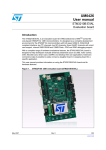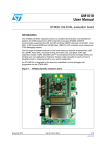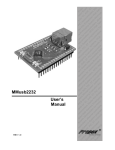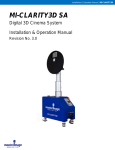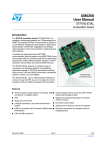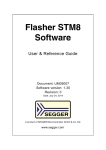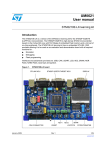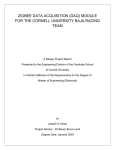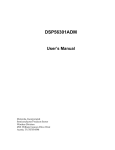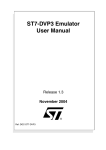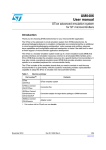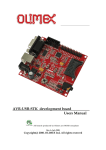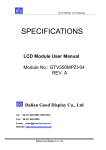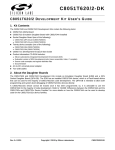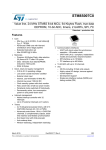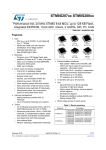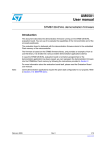Download STM8L101-EVAL evaluation board
Transcript
UM0629 User Manual STM8L101-EVAL evaluation board Introduction The STM8L101-EVAL is composed of two boards: ■ An STM8L1/L2 motherboard called MB709 which includes all peripherals which are connected to the MCU on the daughterboard. The motherboard connects to the daughterboard via two 36-pin connectors. ■ An STM8L1 daughterboard called MB710 which has an STM8L101 MCU. The motherboard and daughterboard are a complete development platform for STMicroelectronic's STM8L101 microcontroller with comparator, I2C, SPI, USART and SWIM debugging support. The full range of hardware features on the STM8L101-EVAL helps you to evaluate all peripherals (MicroSD cardTM, USART, EEPROM, LCD, for example) and develop your own applications. Figure 1. November 2009 STM8L101-EVAL board Doc ID 15312 Rev 2 1/26 www.st.com Contents UM0629 Contents 1 2 3 4 2/26 Overview . . . . . . . . . . . . . . . . . . . . . . . . . . . . . . . . . . . . . . . . . . . . . . . . . . 4 1.1 Features . . . . . . . . . . . . . . . . . . . . . . . . . . . . . . . . . . . . . . . . . . . . . . . . . . . 4 1.2 Demonstration software . . . . . . . . . . . . . . . . . . . . . . . . . . . . . . . . . . . . . . . 4 1.3 Order code . . . . . . . . . . . . . . . . . . . . . . . . . . . . . . . . . . . . . . . . . . . . . . . . . 4 1.4 Hardware layout and configuration . . . . . . . . . . . . . . . . . . . . . . . . . . . . . . . 5 STM8L1/L2 motherboard . . . . . . . . . . . . . . . . . . . . . . . . . . . . . . . . . . . . . 8 2.1 Power supply . . . . . . . . . . . . . . . . . . . . . . . . . . . . . . . . . . . . . . . . . . . . . . . 8 2.2 Reset source . . . . . . . . . . . . . . . . . . . . . . . . . . . . . . . . . . . . . . . . . . . . . . . 9 2.3 Audio . . . . . . . . . . . . . . . . . . . . . . . . . . . . . . . . . . . . . . . . . . . . . . . . . . . . . 9 2.4 I2C EEPROM . . . . . . . . . . . . . . . . . . . . . . . . . . . . . . . . . . . . . . . . . . . . . . 10 2.5 RS-232 . . . . . . . . . . . . . . . . . . . . . . . . . . . . . . . . . . . . . . . . . . . . . . . . . . . 10 2.6 MicroSD card . . . . . . . . . . . . . . . . . . . . . . . . . . . . . . . . . . . . . . . . . . . . . . 10 2.7 Analog input . . . . . . . . . . . . . . . . . . . . . . . . . . . . . . . . . . . . . . . . . . . . . . . 10 2.8 Development and debug support CN5 and CN6 . . . . . . . . . . . . . . . . . . . 10 2.9 Display and input devices . . . . . . . . . . . . . . . . . . . . . . . . . . . . . . . . . . . . . 11 2.10 Bi-color LED . . . . . . . . . . . . . . . . . . . . . . . . . . . . . . . . . . . . . . . . . . . . . . . 11 2.11 Economic measurement and potentiometer RV1 . . . . . . . . . . . . . . . . . . . 11 2.12 MicroSD connector CN1 . . . . . . . . . . . . . . . . . . . . . . . . . . . . . . . . . . . . . . 12 2.13 Daughterboard extension connectors CN3 and CN4 . . . . . . . . . . . . . . . . 13 2.14 SWIM connectors CN5 and CN6 . . . . . . . . . . . . . . . . . . . . . . . . . . . . . . . 14 2.15 RS-232 connector CN8 . . . . . . . . . . . . . . . . . . . . . . . . . . . . . . . . . . . . . . 15 2.16 Audio jack CN9 . . . . . . . . . . . . . . . . . . . . . . . . . . . . . . . . . . . . . . . . . . . . . 15 2.17 Power connector CN10 . . . . . . . . . . . . . . . . . . . . . . . . . . . . . . . . . . . . . . 15 STM8L1 daughterboard . . . . . . . . . . . . . . . . . . . . . . . . . . . . . . . . . . . . . 16 3.1 Power . . . . . . . . . . . . . . . . . . . . . . . . . . . . . . . . . . . . . . . . . . . . . . . . . . . . 16 3.2 Extension connector CN1 and CN2 . . . . . . . . . . . . . . . . . . . . . . . . . . . . . 16 Schematics . . . . . . . . . . . . . . . . . . . . . . . . . . . . . . . . . . . . . . . . . . . . . . . 17 4.1 STM8L1/L2 motherboard . . . . . . . . . . . . . . . . . . . . . . . . . . . . . . . . . . . . . 17 4.2 STM8L1-DB daughterboard schematic . . . . . . . . . . . . . . . . . . . . . . . . . . 23 Doc ID 15312 Rev 2 UM0629 Contents Appendix A STM8L101-EVAL I/O assignment . . . . . . . . . . . . . . . . . . . . . . . . . . . 24 5 Revision history . . . . . . . . . . . . . . . . . . . . . . . . . . . . . . . . . . . . . . . . . . . 25 Doc ID 15312 Rev 2 3/26 Overview UM0629 1 Overview 1.1 Features 1.2 ■ 5 V power jack supply ■ Audio play ■ MicroSD cardTM ■ 64 Kbit I2C EEPROM ■ One channel of RS-232 communication ■ Bi-color LED ■ Economic analog voltage measurement based on comparator ■ SWIM debug support ■ 122 x 32 dot-matrix serial interface LCD module ■ Joystick with 4-direction control and selector ■ Reset and User button ■ 3 LEDs ■ Extension connector for daughterboard ■ One 10 K potentiometer ■ RoHS compliant Demonstration software Demonstration software is preloaded in the board’s Flash memory for easy demonstration of device peripherals in stand-alone mode. For more information and to download the latest version available, refer to STM8L101-EVAL demonstration firmware available on web: www.st.com/mcu. 1.3 Order code To order the STM8L101K3 evaluation board, use the order code STM8L101-EVAL. 4/26 Doc ID 15312 Rev 2 UM0629 1.4 Overview Hardware layout and configuration The STM8L101-EVAL evaluation board is designed around the STM8L101K3T6 in an LQFP32 package. Figure 2 illustrates the connections between the daughterboard and the peripherals on the motherboard (LCD, I2C EEPROM, USART, audio and MicroSD card). Figure 3 and Figure 4 help you to locate these features on the actual evaluation board. Figure 2. Hardware block diagram I2C EEPROM I2C SWIM connector SWIM ADC PWM Audio circuit BEEP Bi-color LED Joystick GPIO’s LED’s USART STM8L1/L2-MB SPI RS232 transceiver Level translator RS232 connector MicroSD card LCD Push button Compa rator BNC connector Economic Measurement 5V power jack ADC Potentiometer STice connector CMP 1.8 to 3.3V regulator 3.3V regulator GPIO’s Extension connector STM8L1/L2-MB (MB709) STM8L101 STM8L1-DB MCU STM8L1-DB (MB710) Doc ID 15312 Rev 2 5/26 Overview Figure 3. UM0629 STM8L1/L2 motherboard layout CN3, CN4 daughterboard connectors CN6 SWIM (ERNI cable alternative) CN5 SWIM RV1 Potentiometer CN8 USART U2 Dot-matrix LCD CN1 Micro SD card™ CN9 Audio jack CN10 5V power RV4 MCU_VDD adjustment 6/26 B1 RESET U7 Joystick Doc ID 15312 Rev 2 B2 KEY UM0629 Overview Figure 4. STM8L1 daughterboard layout CN1, CN2 motherboard connector STM8L101 MCU in LQFP32 package soldered directly onto the board and footprint for socket (ref ENPLAS OTQ-32-0.8-02) is present on the board Doc ID 15312 Rev 2 7/26 STM8L1/L2 motherboard 2 UM0629 STM8L1/L2 motherboard This motherboard is designed to work with an STM8L1 daughterboard. 2.1 Power supply The motherboard is designed to be powered by a 5 V DC power supply and to be protected from a wrong power plug-in event by PolyZen Inc. (auto rearmable fuse) U13. It is possible to configure the evaluation board to provide 5 V power to the daughterboard through the daughterboard connector. ● The motherboard is powered by a 5 V DC power adapter connected to CN10, the power jack on the board (PSU on silk screen for power supply unit). ● 5 V DC power is provided to the daughterboard through an extension connector and can be set by jumper JP12 (DTB for daughterboard on silk-screen). ● MCU_VDD can be selected by setting jumper JP11 and is connected to the daughterboard directly through the daughterboard connector. The power supply is configured by setting the jumpers JP11 and JP12 as described in Table 1. The LED LD6 is lit when the motherboard is powered correctly. JP3 is no longer used. Table 1. Jumper Power related jumpers Description Setting PSU DTB 5 V power from power supply jack (CN10) is connected to the motherboard when JP12 is set as shown to the right: (default setting). JP12 MCU_VDD is powered by a fixed 3.3 V power supply when JP11 is set as shown to the right: (default setting). PSU DTB 5 V power from power supply jack (CN10) is connected to the daughterboard when JP12 is set as shown to the right: In this case the motherboard and daughterboard are powered by a 5 V power supply. 1 JP11 MCU_VDD is powered by a variable power supply from 1.8 V to 3.3 V, adjusted by potentiometer RV4 (bottom left of the board), when JP11 is set as shown to the right: 8/26 Doc ID 15312 Rev 2 1 UM0629 2.2 STM8L1/L2 motherboard Reset source The reset signal of the motherboard is low active. Reset sources include: ● Reset button B1. ● Debugging tools from connectors CN5, CN6. The reset pin PA1 of the STM8L101 is either connected to the reset button B1 or to GND by the setting of jumper JP1: Table 2. Jumper Reset related jumpers Description PA1 is connected to GND when JP1 is set as shown to the right: This configuration is reserved for internal use only. Setting 1 2 3 JP1 PA1 is connected to Reset button when JP1 is set as shown to the right: (default setting). This jumper position is called Alone on the silk-screen. 2.3 1 2 3 Audio The motherboard supports both audio recording and playback, but audio recording components (U11 microphone and U12 amplifier) cannot be used with the STM8L101. The speaker can be disabled or enabled by the setting of jumper JP10. Audio volume can be adjusted using the potentiometer RV2. Table 3. Jumper Audio related jumpers Description JP10 Audio power amplifier TS4871 is forced on standby mode when JP10 is not fitted. Default setting: fitted. JP9 Either beeper or PWM output can be selected as a source of speaker by setting jumper JP9. The beeper is connected to speaker when JP9 is set as shown to the right: (Beep position on the silk-screen). The PWM output is connected to speaker when JP9 is set as shown to the right: (PSW position on the silk-screen) (default setting). Doc ID 15312 Rev 2 Setting 1 2 3 1 2 3 9/26 STM8L1/L2 motherboard 2.4 UM0629 I2C EEPROM A 64 Kbit I2C EEPROM is connected to the I2C port of the STM8L101. Write protection can be enabled by the setting of jumper JP8. Table 4. I2C EEPROM related jumpers Jumper JP8 2.5 Description I2C EEPROM U6 is protected from write operation when JP8 is not fitted. Default setting: Fitted RS-232 One D-type 9-pin RS-232 connector CN8 is available on the motherboard. RS-232 interface behavior is not guaranteed when the MCU is powered by an adjustable voltage lower than 3 V. Note: To communicate with an RS-232 port on a PC, a 9-pin straight RS-232 cable (direct pin to pin connection) is needed because: ● On CN8 the RX signal is connected on pin2 and the TX data on pin 3, ● On the PC side the RX signal is generally on pin 3 and the TX signal on pin 2. This standard 9-pin straight RS-232 cable is not provided with the board. Refer to Section 2.15 for details on RS-232 connector pinout. 2.6 MicroSD card The 1GByte (or more) MicroSD card connected to the SPI of the STM8L101 through a voltage level translator U1 (shared with LCD) is available on the board. MicroSD card chip select is managed by standard I/O port PB4. 2.7 Analog input The BNC connector footprint present on the board (CN7) cannot be used as it is not connected to the MCU. 2.8 Development and debug support CN5 and CN6 The two debug connectors are available on the motherboard. 10/26 ● CN5, ERNI 4-pin connector (reference 284697 or 214017) for SWIM debugging. It fits with ERNI connectors provided with standard tools. ● CN6, 2.54 mm pitch low-cost 4-pin connector for SWIM debugging. Doc ID 15312 Rev 2 UM0629 2.9 STM8L1/L2 motherboard Display and input devices Display devices available are: ● 122x32 dot-matrix serial interface LCD (U2) ● 4 general purpose LED's (LD2,3,4,5) Input devices available are: ● 4-direction joystick ● selection key ● general purpose button (B2) Table 5. 2.10 122x32 dot matrix LCD U13 Pin on U2 Description Pin connection 1 Vss GND 2 Vcc +3V3 3 VO - 4 CLK PB5 5 SID PB6 6 CS PD1 7 A +5V 8 K GND Bi-color LED A bi-color LED is connected to PB0 through a voltage translator which guarantees that the bi-color LED works when the STM8L101 is powered by an adjustable voltage from 1.8 V to 3.3 V. 2.11 Economic measurement and potentiometer RV1 The economic measurement solution is demonstrated based on the internal comparator inside the STM8L101 and potentiometer RV1. As shown in Figure 5, the voltage divided by resister bridge R10 and R11 can be measured by using an internal comparator of the STM8L1, with Vref connected to channel 2 of the comparator and an RC charge circuit connected to the COM channel of the comparator. To measure the voltage Vin from the potentiometer: 1. Compare Vref with the voltage on C8 which is charged by a series of pulses generated by PC4. 2. Record pulse number PN_Vref when the voltage on C8 reaches voltage reference Vref. 3. Another charge pulse PN_Vin can be obtained with voltage connected to CH1 also like PN_Vref. 4. The voltage Vin can be calculated based on both numbers PN_Vref and PN_Vin. Doc ID 15312 Rev 2 11/26 STM8L1/L2 motherboard UM0629 Figure 5. Voltage measurement using internal comparator Table 6. Potentiometer RV1 related jumpers Jumper JP2 2.12 Setting RV1 is connected to PD2 as one input of the internal comparator when JP2 is set as shown to the right: JP2 position is called Comp_PD2 on the silk-screen. 1 2 3 RV1 is not connected when JP2 is set as shown to the right: (default setting). JP2 position is called ADC_PE0 on the silk-screen. 1 2 3 MicroSD connector CN1 Figure 6. 12/26 Description MicroSD connector CN1 viewed from front Doc ID 15312 Rev 2 UM0629 STM8L1/L2 motherboard Table 7. 2.13 MicroSD connector CN1 Pin number Description Pin number Description 1 Reserved 5 SCLK/PB5 2 CS/PB4 6 Vss/GND 3 DI/PB6 7 DO/PB7 4 VDD 8 Reserved 9 GND 10 Not used Daughterboard extension connectors CN3 and CN4 Two 36-pin male headers CN3 and CN4 can be used to connect the daughterboard to the motherboard. All GPI/Os are available on it. Please refer to Table 8 and Table 9 for pin-out definition. Table 8. Daughterboard extension connector CN3 Pin number Description Pin number Description 1 GND 2 PC4 3 PC5 4 PC6 5 Reserved 6 Reserved 7 Reserved 8 Reserved 9 PA0 10 GND 11 PA1 12 PA2 13 Reserved 14 PA3 15 Reserved 16 Reserved 17 PA4 18 Reserved 19 GND 20 PA5 21 Reserved 22 PA6 23 Reserved 24 Reserved 25 PD0 26 Reserved 27 PD2 28 PD1 29 PD3 30 GND 31 NC 32 NC 33 PB0 34 PB1 35 PB2 36 PB3 Doc ID 15312 Rev 2 13/26 STM8L1/L2 motherboard Table 9. 2.14 UM0629 Daughterboard extension connector CN4 Pin number Description Pin number Description 1 GND 2 PC3 3 PC2 4 PC1 5 PC0 6 Reserved 7 Reserved 8 Reserved 9 Reserved 10 GND 11 RESET# 12 Reserved 13 Reserved 14 Reserved 15 PD7 16 Reserved 17 PD5 18 PD6 19 D5V 20 PD4 21 NC 22 PB7 23 NC 24 MCU_VDD 25 PB6 26 PB5 27 PB4 28 Reserved 29 Reserved 30 GND 31 Reserved 32 Reserved 33 Reserved 34 Reserved 35 Reserved 36 Reserved SWIM connectors CN5 and CN6 CN6 is a low cost 2.54 mm pitch connector to be used by customers who do not have the ERNI cable. 14/26 Figure 7. SWIM debugging connector CN5 viewed from above PCB Table 10. SWIM debugging connectors CN5 and CN6 Pin number Description Pin number Description 1 VDD 2 PA0 3 GND 4 RESET# Doc ID 15312 Rev 2 UM0629 2.15 STM8L1/L2 motherboard RS-232 connector CN8 Figure 8. RS-232 connector CN8 viewed from front Table 11. RS-232 connector CN8 Pin number 2.16 Description Pin number Description 1 NC 6 Connect to Pin 4 2 USART_RXD/PC2 7 Connect to Pin 8 3 USART_TXD/PC3 8 Connect to Pin 7 4 Connect to Pin 6 9 NC 5 GND Audio jack CN9 A 3.5 mm mono audio jack CN9 is available on the motherboard. The speaker U9 is bypassed when an earphone is plugged into CN9 (CN9 is compatible with audio plug NYS231 from NEUTRIK). 2.17 Power connector CN10 The motherboard can be powered from a DC 5 V power supply via the external power supply jack CN10 shown in Figure 9. The central pin of CN10 must be positive. Figure 9. Power supply connector CN10 viewed from front Doc ID 15312 Rev 2 15/26 STM8L1 daughterboard UM0629 3 STM8L1 daughterboard 3.1 Power The STM8L101 MCU is powered by MCU_VDD from the motherboard through an extension connector on the board. It is enabled by setting the jumper JP1 as described in Table 12. Table 12. Power related jumper* Jumper JP1 3.2 Description Enables consumption measurement of VDD when the jumper is removed and replaced by an ammeter. Default setting: Fitted. Extension connector CN1 and CN2 The 36-pin connectors CN1 and CN2 are designed to be connected to the motherboard. The pin-out definition is the same as CN3 and CN4 on the motherboard which is described in Section 2.13. Warning: 16/26 On MB710 PCB rev B, CN2 (pin 26) silk-screen PB5 is missing Doc ID 15312 Rev 2 Schematics 4.1 STM8L1/L2 motherboard UM0629 4 Figure 10. STM8L1 motherboard schematic U_Audio Audio.SchDoc U_MCU MCU.SchDoc MIC_OUT Audio_PWM BEEP MIC_OUT Audio_PWM BEEP Doc ID 15312 Rev 2 U_LCD_MicroSD LCD_MicroSD.SchDoc SPI_MISO SPI_MOSI SPI_SCK MicroSD_CS LCD_CS SDcard_detect U_Power Power.SchDoc SPI_MISO SPI_MOSI SPI_SCK MicroSD_CS LCD_CS SDcard_detect U_Peripherals Peripherals.SchDoc I2C_SLK I2C_SDA LED4 LED3 LED2 LED1 BiD_LED USART_RX USART_TX User_Button JOY_UP JOY_RIGHT JOY_LEFT JOY_DOWN JOY_SEL Potentiometer BNC I2C_SLK I2C_SDA LED4 LED3 LED2 LED1 BiD_LED USART_RX USART_TX User_Button JOY_UP JOY_RIGHT JOY_LEFT JOY_DOWN JOY_SEL Potentiometer BNC 17/26 Title: STM8L1/L2-MB Number:MB709 Rev: A.1(PCB.SCH) Date: 1/21/2009 Sheet 1 of 6 Schematics STMicroelectronics Schematics 18/26 Figure 11. STM8L1 motherboard MCU MCU_VDD R15 JP1 10K RESET# 1 2 3 VDDA L1 JP3 Not Fitted BEAD C11 10uF CN3 VDD C6 100nF C12 10nF EX_PC5 PC7 PH1 PA0 PA1 PG4 PG6 PA4 C7 100nF U4 R17 JOY_DOWN User_Button Doc ID 15312 Rev 2 VDD VDDA BNC MIC_OUT Audio_PWM LCD_CS BiD_LED JOY_LEFT JOY_RIGHT JOY_UP PA1 PA2 60 PA3 PG4 PG5 PG6 PG7 PA4 PA5 PA6 PG0 PG1 PG2 PG3 PD0 PD1 PD2 PD3 PB0 PB1 PB2 PB3 PE0 PE1 PE2 PE3 PE4 PE5 1 2 3 4 5 6 7 8 9 10 11 12 13 14 15 16 17 18 19 20 21 22 23 24 25 26 27 28 29 30 31 32 PA1/NRST PA2/HSE_IN PA3/HSE_OUT PG4 PG5 PG6 PG7 PA4/ADC_IN15/TIM2_BKIN PA5/ADC_IN14/TIM3_BKIN PA6/ADC_IN13/COMP_REF VSSA VSS VDD VDDA PG0/REF+ PG1/REFPG2/ADC_IN12 PG3/ADC_IN11 PD0/TIM3_CH2/COMP1_CH3 PD1/TIM3_TRIG/COMP1_CH4 PD2/COMP2_CH3 PD3/COMP2_CH4 PB0/TIM2_CH1/COMP1_CH1 PB1/TIM3_CH1/COMP1_CH2 PB2/ TIM2_CH2/COMP2_CH1 PB3/TIM2_TRIG/COMP2_CH2 PE0/ADC_IN2 PE1/ADC_IN1 PE2/ADC_IN0 PE3 PE4 PE5 PA0/SWIM/BEEP/IR_TIM PH2 PH1 PH0 PC7 PC6/LSE_OUT PC5/LSE_IN PC4/USART_CK/CCO PC3/USART_TX PC2/USART_RX PC1/I2C_SCL PC0/I2C_SDA PF7 PF6 PF5 PF4 PF3 PF2 PF1 PF0 PD7 PD6 PD5 PD4 VDD VSS PB7/SPI_MISO PB6/SPI_MOSI PB5/SPI_SCK PB4/SPI_NSS PE7 PE6 PA0 PH2 PH1 PH0 PC7 PC6 PC5 PC4 PC3 PC2 PC1 PC0 PF7 PF6 PF5 PF4 PF3 PF2 PF1 PF0 PD7 PD6 PD5 PD4 64 63 62 61 60 59 58 57 56 55 54 53 52 51 50 49 48 47 46 45 44 43 42 41 40 39 38 37 36 35 34 33 JP7 solder bridge 1 BEEP 2 PG0 PG2 PD0 PD2 PD3 EX_PC6 EX_PC5 3 JP6 C13 3 PB0 PB2 2 USART_TX USART_RX I2C_SLK I2C_SDA 1 solder bridge X2 Not Fitted 10pF 1 3 5 7 9 11 13 15 17 19 21 23 25 27 29 31 33 35 2 4 6 8 10 12 14 16 18 20 22 24 26 28 30 32 34 36 RESET# PA3 PG5 PG7 PA5 PC4 EX_PC6 PH0 PH2 JP4 PG5 PG7 PA5 PA6 PG1 PG3 PD1 PA2 PA3 JP5 PB1 PB3 VDD PG0 PG2 PD0 PD2 PB0 PB2 PE0 PE2 PE4 PE6 PB4 PB6 PD4 PD6 PF0 PF2 PF4 PF6 PC0 PC2 PC4 1 C5 100nF 4 1 CN2 VDD MCU_VDD B1 RESET Not Fitted 2 3 2 X1 Header 18X2 on the left 4 C10 20pF 3 C9 20pF C14 10pF CN4 SDcard_detect LED4 JOY_SEL LED3 LED2 LED1 VDD PB7 PB6 PB5 PB4 PE7 PE6 PC2 PC0 PF6 PF4 RESET# R18 SPI_MISO SPI_MOSI SPI_SCK MicroSD_CS 820 PF1 PD7 PD5 D5V PB6 PB4 PE6 PE4 PE2 PE0 Not Fitted 1 3 5 7 9 11 13 15 17 19 21 23 25 27 29 31 33 35 2 4 6 8 10 12 14 16 18 20 22 24 26 28 30 32 34 36 EX_PC6 PH0 PH2 PC3 PC1 PF7 PF5 PF3 PF2 PF0 PD6 PD4 PB7 PB5 PE7 MCU_VDD PE5 PE3 PE1 MCU Header 18X2 on the right Exension connector 1 Potentiometer MCU_VDD CN5 1 2 3 4 214017 SWIM connector CN6 PA0 RESET# R9 0 1 2 3 4 PE0 2 3 1 3 5 7 9 11 13 15 17 19 21 23 25 27 29 31 33 35 37 39 41 43 45 47 49 51 53 55 57 59 61 63 65 67 69 71 73 75 77 79 81 83 85 87 89 91 93 95 97 99 101 103 105 107 109 111 113 115 117 119 2 4 6 8 10 12 14 16 18 20 22 24 26 28 30 32 34 36 38 40 42 44 46 48 50 52 54 56 58 60 62 64 66 68 70 72 74 76 78 80 82 84 86 88 90 92 94 96 98 100 102 104 106 108 110 112 114 116 118 120 G1 G1 G2 G2 G4 G4 G3 G3 PA2 PG4 PG6 PA4 PA6 PG1 PG3 PD1 PD3 PB1 PB3 PE1 PE3 PE5 PE7 PB5 PB7 PD5 PD7 PF1 PF3 PF5 PF7 PC1 PC3 VDDA VDD EX_PC5 PC7 PH1 PA0 +3V3 JP2 R11 R12 29K PD3 R13 4K PC4 R10 25K PD2 Not Fitted 8K R14 10K PA6 C8 100nF STice connector Comparator STMicroelectronics Title: SWIM connector Economic measurement STM8L1/L2-MB MCU Number:MB709 Rev: A.1(PCB.SCH) Date: 10/12/2009 Sheet 2 of 6 UM0629 609-1306-ND(2. 54mm) SWIM connector UM0629 Figure 12. STM8L1 motherboard LCD and SD CN1 +3V3 R7 4K7 3 +3V3 R54 MicroSD_CS T1 9013 2 8 7 6 5 4 3 2 1 SW1 SW2 10 9 SDcard_detect PJS008-2000 (SMS064FF or SMS128FF) 1K 1 MicroSD card +3V3 Doc ID 15312 Rev 2 MCU_VDD C1 100nF C2 +3V3 100nF R1 R2 do not fit do not fit MCU_VDD C3 +3V3 100nF U2 1 2 3 4 5 6 7 8 U1 R6 do not fit LCD_CS SPI_MISO R3 R5 0 0 SPI_SCK SPI_MOSI 1 2 3 4 5 6 7 VL VCC IOVL_1 IOVCC_1 IOVL_2 IOVCC_2 IOVL_3 IOVCC_3 IOVL_4 IOVCC_4 NC NC GND THREE_STATE MAX3378EEUD 14 13 12 11 10 9 8 R55 do not fit R69 0 R4 0 Vss Vcc VO CLK SID CS A K HXM122032-GB1 LCD +5V MCU_VDD Title: 19/26 STM8L1/L2-MB LCD&SD Number:MB709 Rev: A.1(PCB.SCH) Date: 1/21/2009 Schematics STMicroelectronics 1 2 3 4 +5V LD1 MCU_VDD U3 1 VCCA VCCB 2 GND DIR 3 BiD_LED A B CN7 R19 10K 1 2 3 4 5 BNC MCU_VDD +3V3 R41 4K7 VB334 (do not fit) 3 User_Button 3 100 2 R16 300 SN74LVC1T45DCKT Bi-color LED R38 LED2 600 R39 2 100nF 8 7 6 5 U6 R40 MCU_VDD C16 LED3 600 1 2 3 4 LED4 600 User Button E0 E1 E2 VSS VCC WC SCL SDA R35 10K JP8 LEDs 9 6 C26 0.1uF R1in T2in T2out R2out R2in V- GND R30 10K R31 10K R32 10K R33 10K R34 10K Selection 3 1 4 6 100nF R1out 14 0 0 0 0 0 100nF T1out 4 R24 R25 R26 R27 R28 JOY_SEL JOY_DOWN JOY_LEFT JOY_RIGHT JOY_UP C22 C2+ T1in C24 0.1uF 100nF 10K 10 C1- 5 C21 R8 12 C2- C20 0 C1+ 16 100nF USART_RX R29 VCC COMMON 2 1 6 2 7 3 8 4 9 5 100nF 11 USART_TX V+ do not fit R46 MCU_VDD C19 3 I2C_SLK I2C_SDA U7 5 100 C18 C25 0.1uF 0 0 EEPROM CN8 DB9-male USART1 C17 100nF U8 1 R42 R43 4K7 4K7 R22 R23 R45 MCU_VDD 2 2 M24C64-RMN6 Potentiometer C23 0.1uF R36 300 1 LED1 600 RV1 10K 0 MCU_VDD MCU_VDD R37 1 Doc ID 15312 Rev 2 R21 LD4 Orange 1 2 LD5 Blue 1 R44 MCU_VDD Potentiometer C15 100nF 4 1 B2 USER 6 5 4 L-317EGW-SS 2 LD3 Green 1 2 0 2 BNC connector R20 LD2 Red 1 +5V Schematics 20/26 Figure 13. STM8L1 motherboard peripherals DWON LEFT RIGHT UP MT008-A 13 7 8 Joystick 15 STMicroelectronics ST3232ECTR Title: STM8L1/L2-MB Peripherals Number:MB709 1 2 3 Rev: A.1(PCB.SCH) Date: 1/21/2009 4 Sheet 4 of 6 UM0629 RS232 +3V3 C30 Speaker- R50 10K TP1 Audio 3 RV2 50K JP9 2 R53 1 ST-613 Speaker+ U10 C34 1 4 3 2 R57 2.2uF R58 0(don't solder) 3 C31 33nF 33K Standby VinVin+ Bypass Uout1 Vout2 VCC GND 5 8 6 7 +3V3 C27 100nF TS4871IST BEEP U9 KDMG15008-03 1 10 2 47K JP10 2 1.2K 2 1 CN9 470pF R52 1 Audio_PWM UM0629 Figure 14. STM8L1/L2 motherboard audio C36 100uF C35 2.2uF R47 0 Speaker C29 R56 1K U11 KECG2740TBL 2 1 10uF R51 100 R59 2.2K C37 47pF C28 5 MCU_VDD TP3 MIC+ 3 100nF U12 TS461CLT 1 TP2 MIC_OUT R48 0 R49 0 MIC_OUT 4 2 Doc ID 15312 Rev 2 MCU_VDD 1 MCU_VDD C38 do not fit RV3 do not fit C39 C40 4.7uF 15K R61 100K R62 18K R63 680 2 3 R60 100K R64 C42 2.2uF 180pF R65 82K C41 4.7uF STMicroelectronics 21/26 Title: STM8L1/L2-MB Audio Number:MB709 Rev: A.1(PCB.SCH) Date: 1/21/2009 Sheet Schematics Microphone Schematics U13 ZEN056V130A24LS 2 Z1 SMAJ5.0A-TR 2 DC-10B Doc ID 15312 Rev 2 D5V E5V SV TP6 5V JP12 1 3 C43 100nF 2 4 Header 2X2 +5V R66 CV SG CG1 CG2 CG3 3 4 5 6 3 C44 10uF Vin C47 470uF +3V3 1 2 Vout GND 1 MCU_VDD 2 C45 10uF C48 100nF 3 JP11 1 3 BNX002-01 LD6 red 1 TP7 Ground TP5 VCC_ADJ U16 LD1086D2M +5V 3 Vin VCC_ADJ Vout ADJ 1 2 1K 2 R67 165 C49 100nF 1 1 2 3 TP4 +3V3 U14 LD1086D2M33 +5V C46 10uF R68 75 3 CN10 E5V U15 2 RV4 3314J-201 1 22/26 Figure 15. STM8L1 motherboard power Title: STM8L1/L2-MB Power Number:MB709 Rev: A.1(PCB.SCH) Date: 9/23/2009 UM0629 STMicroelectronics STM8L1-DB daughterboard schematic UM0629 4.2 Figure 16. Daughterboard schematic U1 PA1 PA2 PA3 PA4 PA5 PA6 VDD JP1 C3 100nF Doc ID 15312 Rev 2 PD0 PD1 PD2 PD3 PB0 PB1 PB2 PB3 PA1/NRST PA2 PA3 PA4/TIM2_BKIN PA5/TIM3_BKIN PA6/COMP_REF VSS VDD PD0/TIM3_CH2/COMP1_CH3 PD1/TIM3_TRIG/COMP1_CH4 PD2/COMP2_CH3 PD3/COMP2_CH4 PB0/TIM2_CH1/COMP1_CH1 PB1/TIM3_CH1/COMP1_CH2 PB2/ TIM2_CH2/COMP2_CH1 PB3/TIM2_TRIG/COMP2_CH2 PA0/SWIM/BEEP/IR_TIM PC6 PC5 PC4/USART_CK/CCO PC3/USART_TX PC2/USART_RX PC1/I2C_SCL PC0/I2C_SDA PD7 PD6 PD5 PD4 PB7/SPI_MISO PB6/SPI_MOSI PB5/SPI_SCK PB4/SPI_NSS 32 31 30 29 28 27 26 25 24 23 22 21 20 19 18 17 PA0 PC6 PC5 PC4 PC3 PC2 PC1 PC0 PD7 PD6 PD5 PD4 PB7 PB6 PB5 PB4 CN3 QTH-030-01-L-D-A RESET# PA3 PA5 PD0 PD2 PB0 PB2 PB4 PB6 PD4 PD6 PC0 PC2 PC4 PC6 STM8L101K3T QFP32 and OTQ-32-0.8-02 double footprint PC5 PA0 PA1 PA4 PD0 PD2 PD3 PB0 PB2 1 3 5 7 9 11 13 15 17 19 21 23 25 27 29 31 33 35 CN2 Right 2 4 6 8 10 12 14 16 18 20 22 24 26 28 30 32 34 36 PC4 PC6 PC2 PC0 PA2 PA3 RESET# R2 820 PD7 PD5 PA5 PA6 D5V PB6 PB4 PD1 PB1 PB3 SSQ-118-03-G-D 1 3 5 7 9 11 13 15 17 19 21 23 25 27 29 31 33 35 2 4 6 8 10 12 14 16 18 20 22 24 26 28 30 32 34 36 PC3 PC1 PD6 PD4 PB7 PB5 PD1 PD3 PB1 PB3 PB5 PB7 PD5 PD7 PC1 PC3 PC5 PA0 VDD MCU_VDD 60-pins Connector for STICE SSQ-118-03-G-D 23/26 Title: STM8L1-DB Number:MB710 2 3 Rev: B.1(PCB.SCH) Date: 10/12/2009 4 Sheet 1 of 1 Schematics STMicroelectronics Extension connector 1 PA2 PA4 PA6 2 4 6 8 10 12 14 16 18 20 22 24 26 28 30 32 34 36 38 40 42 44 46 48 50 52 54 56 58 60 GND GND GND GND CN1 Left 1 3 5 7 9 11 13 15 17 19 21 23 25 27 29 31 33 35 37 39 41 43 45 47 49 51 53 55 57 59 61 62 63 64 MCU_VDD 1 2 3 4 5 6 7 8 9 10 11 12 13 14 15 16 STM8L101-EVAL I/O assignment Appendix A Table 13. STM8L101 pin number 24/26 UM0629 STM8L101-EVAL I/O assignment STM8L101-EVAL input and output assignment Pin name STM8L101-EVAL pin assignment STM8L101 pin number Pin name STM8L101-EVAL pin assignment 1 PA1 - NRESET RESET 17 PB4 SD_card_CS 2 PA2 Unused 18 PB5 SPI_SCK 3 PA3 Unused 19 PB6 SPI_MOSI 4 PA4 Joystick down 20 PB7 SPI_MISO 5 PA5 User button 21 PD4 LED 1 6 PA6 COMP_REF 22 PD5 LED 2 7 VSS GND 23 PD6 LED 3 8 VDD VDD 24 PD7 Joystick select 9 PD0 Audio PWM_out 25 PC0 I²C_SDA_E2P 10 PD1 LCD_CS 26 PC1 I²C_SCL_E2P 11 PD2 CMP2_Potentiometer 27 PC2 USART_RX 12 PD3 CMP2_VREF 28 PC3 USART_TX 13 PB0 Bi-color LED 29 PC4 VREF_CTRL 14 PB1 Joystick left 30 15 PB2 Joystick right 31 16 PB3 Joystick up 32 PA0 SWIM / Beep Doc ID 15312 Rev 2 UM0629 5 Revision history Revision history Table 14. Document revision history Date Revision Changes 29-Jan-2009 1 Initial release. 06-Nov-2009 2 Removed STice and IrDA functionality. Modified , Section 2.5, Section 2.6 Table 2, Table 3, Table 6, Table 12, Table 13, Figure 2, Figure 3, Figure 4 all schematics and Appendix A. Doc ID 15312 Rev 2 25/26 UM0629 Please Read Carefully: Information in this document is provided solely in connection with ST products. STMicroelectronics NV and its subsidiaries (“ST”) reserve the right to make changes, corrections, modifications or improvements, to this document, and the products and services described herein at any time, without notice. All ST products are sold pursuant to ST’s terms and conditions of sale. Purchasers are solely responsible for the choice, selection and use of the ST products and services described herein, and ST assumes no liability whatsoever relating to the choice, selection or use of the ST products and services described herein. No license, express or implied, by estoppel or otherwise, to any intellectual property rights is granted under this document. If any part of this document refers to any third party products or services it shall not be deemed a license grant by ST for the use of such third party products or services, or any intellectual property contained therein or considered as a warranty covering the use in any manner whatsoever of such third party products or services or any intellectual property contained therein. UNLESS OTHERWISE SET FORTH IN ST’S TERMS AND CONDITIONS OF SALE ST DISCLAIMS ANY EXPRESS OR IMPLIED WARRANTY WITH RESPECT TO THE USE AND/OR SALE OF ST PRODUCTS INCLUDING WITHOUT LIMITATION IMPLIED WARRANTIES OF MERCHANTABILITY, FITNESS FOR A PARTICULAR PURPOSE (AND THEIR EQUIVALENTS UNDER THE LAWS OF ANY JURISDICTION), OR INFRINGEMENT OF ANY PATENT, COPYRIGHT OR OTHER INTELLECTUAL PROPERTY RIGHT. UNLESS EXPRESSLY APPROVED IN WRITING BY AN AUTHORIZED ST REPRESENTATIVE, ST PRODUCTS ARE NOT RECOMMENDED, AUTHORIZED OR WARRANTED FOR USE IN MILITARY, AIR CRAFT, SPACE, LIFE SAVING, OR LIFE SUSTAINING APPLICATIONS, NOR IN PRODUCTS OR SYSTEMS WHERE FAILURE OR MALFUNCTION MAY RESULT IN PERSONAL INJURY, DEATH, OR SEVERE PROPERTY OR ENVIRONMENTAL DAMAGE. ST PRODUCTS WHICH ARE NOT SPECIFIED AS "AUTOMOTIVE GRADE" MAY ONLY BE USED IN AUTOMOTIVE APPLICATIONS AT USER’S OWN RISK. Resale of ST products with provisions different from the statements and/or technical features set forth in this document shall immediately void any warranty granted by ST for the ST product or service described herein and shall not create or extend in any manner whatsoever, any liability of ST. ST and the ST logo are trademarks or registered trademarks of ST in various countries. Information in this document supersedes and replaces all information previously supplied. The ST logo is a registered trademark of STMicroelectronics. All other names are the property of their respective owners. © 2009 STMicroelectronics - All rights reserved STMicroelectronics group of companies Australia - Belgium - Brazil - Canada - China - Czech Republic - Finland - France - Germany - Hong Kong - India - Israel - Italy - Japan Malaysia - Malta - Morocco - Philippines - Singapore - Spain - Sweden - Switzerland - United Kingdom - United States of America www.st.com 26/26 Doc ID 15312 Rev 2



























